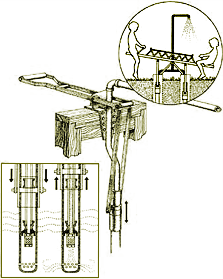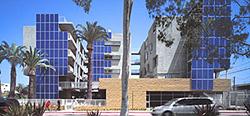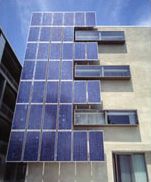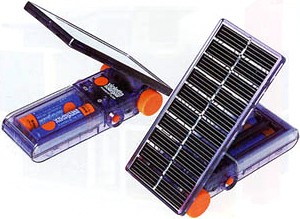energy
Pocket Full of Sunshine
Just after sunset, the lights come back on to applause in the street. Email checked, I should probably write something about design and the last 24 hours in New York City. Something about flashlights, candles, and radios; bridges and tunnels, skyscrapers, and long walks home; acoustic guitars, drums, and old clarinets; block parties and bon fires; cellular, cordless, analog and pay phones, and just plain hollerin from the street; public parks in times of crisis, generators and hot dogs, gas-burning pizza ovens, second-hand books, cool breezes, and a long nap on an August afternoon; energy efficiency and sustainable design; infrastructure, ideology, and public policy; and the stars returning briefly to the night sky over Manhattan.
Instead, I’m going out to find something to eat.
I leave you with this:
Studio del Sole’s Violetta Solargear is a pocket-sized solar power charger for AA and AAA Ni-MH batteries. They also sell a USB extension and a DC adapter to power your mobile phone, PDA, music player, or Game Boy. A personal solar panel for your personal electronic device. It’s just so elegant.
Gaviotas

In 1965 Paulo Lugari was flying over the impoverished Llanos Orientales, the “eastern plains” that border Venezuela. The soil of the Llanos is tough and acidic, some of the worst in Colombia. Lugari mused that if people could live here they could live anywhere.
The following year Lugari and a group of scientists, artists, agronomists and engineers took the 15-hour journey along a tortuous route from Bogota to the Llanos Orientales to settle. The local population, including the indigenous Guahibo people, familiar with the political terror and violence of the ‘white man,’ were naturally suspicious.
Nearly 40 years later, while war rages across Colombia with the help of U.S. funds, equipment, and training, the 200 residents of Gaviotas, including farmers, scientists, artists, and former street kids, have created a thriving village and environmental research center in Vichada in Los Llanos.
“Gaviotas is named after a bird that enlivens the rivers at dusk.” [source]
“They have planted millions of trees, thus regenerating an indigenous rainforest. They farm organically and use wind and solar power. Every family enjoys free housing, community meals, and schooling. There are no weapons, no police, no jail. There is no mayor.” [source]
“Gaviotas provided a chance to plan a tropical civilization from the ground up, instead of depending on technologies developed for northern climates. ‘When we import solutions from the US or Europe,’ said Lugari, founder of Gaviotas, ‘we also import their problems.’
Over the years Gaviotas technicians have installed thousands of the windmills across Colombia - in some places gaviotas is the local word for windmill.”
Around 58 types of windmill were tried and tested before the pioneers came up with determined that the distinctive ‘sunflower’ design functioned best in the plains.
 “Since Gaviotas refuses to patent inventions, preferring to share them freely, the design has been copied from Central America to Chile.
“Since Gaviotas refuses to patent inventions, preferring to share them freely, the design has been copied from Central America to Chile.
Electricity comes from a low-head turbine powered by a stream, except in the short dry season, when it is backed up by a diesel generator. ‘In 24 years we’ve learned to cover 70 percent of our food and energy needs,’ says Gonalo Bernal, administrator of Gaviotas. ‘The trees we plant more than compensate for any greenhouse gases we emit. Imagine if the rest of the world lived like us.’
Gaviotas began as a collection of researchers, students, and laborers sharing vehicles, bedding, dishes, clothes - and decisions. In time several of their families joined them and a permanent colony with individual houses emerged. Government was by consensus and unwritten rules. To limit public disorder, alcohol is confined to homes. To preserve wildlife, dogs and guns are banished. A need for police, jail, or door locks has never arisen. Anyone who violates protocol, like a storekeeper who recently admitted to overcharging, is ostracized by the community until his debt is paid. Loafers aren’t tolerated, but with wages above the Colombian minimum wage, plus free meals, medical care, schools, and housing, loafing isn’t a problem.
A techno-tour of the llanos shows how Gaviotas has revolutionized life here. The most significant invention is a simple hand pump capable of tapping aquifers six times deeper than conventional models, but requiring so little effort that children can operate it. In normal pumps a heavy piston must be raised and lowered inside a pipe. Gaviotas engineers realized they could do the reverse; leave the piston stationary and lift an outer sleeve of lightweight, inexpensive PVC tubing instead.”
 “In the open-air Gaviotas preschool, the children’s see-saw is actually a pump in disguise. As they rise and descend, water gushes from a vertical pipe into an open cement tank. Over the years Gaviotas technicians have installed these in thousands of school yards, using kid power to provide villages with clean water. This simple, inexpensive pump has revolutionised rural life across Colombia for people who used to haul their water in buckets from muddy tropical rivers.” [source]
“In the open-air Gaviotas preschool, the children’s see-saw is actually a pump in disguise. As they rise and descend, water gushes from a vertical pipe into an open cement tank. Over the years Gaviotas technicians have installed these in thousands of school yards, using kid power to provide villages with clean water. This simple, inexpensive pump has revolutionised rural life across Colombia for people who used to haul their water in buckets from muddy tropical rivers.” [source]
“At a windmill-fed cattle trough, surrounded by a sloping cement floor, cowboys have just brought several thirsty calves. As they drink, their dung slides down the slope into a gutter, which sluices it to an enclosed anaerobic fermentation tank, where the cow-pie slurry turns into compost and methane.
The methane flows through pipes to the 16-bed Gaviotas hospital, which a Japanese architectural journal has named one of the 40 most important buildings in the world. It is at once both futuristic and ancient, a maze of angles formed by white walls, glass awnings, skylights, brushed steel columns, and exposed supports trimmed in blue and yellow enamel. The interior is cooled with underground ducts whose hillside intakes face the prevailing breeze. Opposing layers of corrugated roofing create a series of air channels that further bleed away the heat. The combined effect is cost-free, maintenance-free air conditioning. Solar collectors on the roof alternately heat, boil, and distill water. Electricity is from solar photovoltaic cells.
The only hospital within a 12-hour radius, it serves all comers, including both guerrilla and army forces battling in the area. ‘The rule here is never to ask,’ says Bernal. ‘Like the Red Cross, everybody respects us.’
A short, vine-covered walkway connects the Gaviotas hospital to the maloks, a separate wing built by the local Guahivo Indians. Instead of beds, patients and their families lie in hammocks hung from wooden beams under a great thatch roof. Relatives of the sick tend crops of tomatoes, lettuce, and onions in an adjacent hydroponic greenhouse.
If the National University’s pharmacology department and the Guahivo shamans have their way, this greenhouse will one day become the finest medical plant laboratory in the tropics. But money is a critical factor, and Colombia’s expanding, government-owned oil and gas industry has dampened Gaviotas’ solar collector sales by blocking tax benefits for investing in alternative energy. At  the same time revenue from windmills and pumps dropped as Colombian agriculture was battered by an unexpected onslaught of cheap imported foods, the fallout of new free trade policies.
the same time revenue from windmills and pumps dropped as Colombian agriculture was battered by an unexpected onslaught of cheap imported foods, the fallout of new free trade policies.
So Gaviotas has decided to scale down its manufacturing. But no one is getting laid off. ‘Gaviotas isn’t a company,’ Lugari says, ‘we’re a community. In fact the solution means that both employment and Gaviotas will grow.’
The solution is the nearly 20,000 forested acres. In the past 12 years, Gaviotas has planted 1.6 million Caribbean pines (after finding that no indigenous tree would grow on the prairie). To the surprise of foresters, Gaviotans chose not to cut their standing timber. Instead they are converting their windmill factory to process pine resin. Colombia spends $4 million annually to import such resins for the manufacture of paint, turpentine, and paper. Armed with that fact, Lugari persuaded the Japanese government to provide the seed money, via a grant through the Interamerican Development Bank, to begin tapping and processing resin for the domestic market.” [source]
Since the above was written in 1995, the community no longer purhcases diesel fuel and is now totally energy independent. They generate power with turbine engines fueled by the resin of the Carribean pine trees in their forest. These pines are being slowly crowded out by the regeneration of indigenous rainforest. [source]
Other inventions include:
- a high pressure solar cooker
- methane burners
- hot-water solar panels
- parabolic solar grain driers
- self-cooling rooftops
- cooling wind corridors
- corkscrewing manual well digger
- variety of highly efficient and durable windmills
- specialized bicycle for the Llanos
- pedal powered cassava grinder (10 hours work done in 1 hour)
- rotating drum peanut sheller
- ox-drawn land graders
- one-handed sugarcane press
Gaviotas engineers also designed a solar kettle for the hospital. According to engineer Jaime Dávila, “the principle begins with an old country custom: boil water one day to drink the next, after it cools.” Dávila’s goal was an inexpensive solar-operated system that would give unlimited boiled drinking water, already cooled to room temperature, straight from a tap any time of day, and would work under cloudy skies. The kettle took six years to perfect. It combines solar panels, storage tanks, an efficient heat exchanger, a bit of distillation and a spigot — which you turn to draw off potable water.[source]
See some renderings of their solar collectors, solar oven, and wind-powered musical organ.
ISO 14001 Reconsidered
Reader Desmond B. writes:
“Browsing through your site, I was interested by your relatively neutral presentation of the ISO programme. You presented some interesting aspects of the bureaucratic inanities, as well as some of the difficulties of applying euro-centric standards (the symbology not being applicable worldwide) on a global scale. It seems as though there are many positive aspects to the ISO programme (your mention of Toyota’s practices), it appears that there is relatively little citizen/democratic control or oversight of this organisation. It’s one thing to standardise container sizes, but environmental management procedures should perhaps be a more public affair. Curious to see some critical comment from you regarding this, especially considering the frequent mentions of ISO on your site.”
True enough. In my two posts that mention the ISO I was fairly neutral. I was less concerned about democratic accountability of the ISO because the standard setting process is fairly open and decentralized, and standards compliance is entirely voluntary. It is up to governments, not the ISO, to legislate, regulate, or enforce implementation of the standards.
 Standards are developed by consensus of broad-based technical committees and working groups. According to the ISO site:
Standards are developed by consensus of broad-based technical committees and working groups. According to the ISO site:
“In these committees, qualified representatives of industry, research institutes, government authorities, consumer bodies, and international organizations from all over the world come together as equal partners in the resolution of global standardization problems.”
Though the views of these interests are taken into account in the standard development process, only ISO “member bodies” can actually participate in the final vote. A member body of ISO is the national body ‘most representative of standardization in its country’. Only one such body is accepted from each country.
That said, the ISO’s consensus process is becoming less open:
“As part of the streamlining of existing procedures, ISO committees will in future, subject to certain conditions, have the option of dispensing with the committee stage — the part of the ISO process during which national positions are debated in order to reach consensus within an ISO committee — and with the final approval stage, during which the texts of final standards are submitted for formal approval by the full ISO membership.” [source]
The ISO’s patent policy highlights the need for more public participation, accountability, and oversight.
The ISO requires individual or corporation’s holding patent rights on any part of an ISO standard to grant usage rights freely or under “reasonable and non-discriminatory terms and conditions” that apply throughout the world. While this may seem fair, the working committee of the relevant standard determines what is “reasonable and non-discriminatory.” This policy has kept some technical standards out of the public domain and from being implemented in some Free Software projects. For instance, it is impossible to write Free Software which can encode or decode MPEG-2 video or encode or decode MPEG-1 Layer 3 audio in the United States. When the organzation that sets standards for the Internet, the W3C, floated its own draft policy considering “reasonable and non-discriminatory” licensing fees, it was widely condemned in public comment and eventually dropped in favor of a draft with royalty-free licenses.
As Desmond notes, though, environmental management procedures are a different matter from, say, standard paper sizes.
The major requirements of an Environmental Management System (EMS) under ISO 14001 include:
- Issuing a policy statement which includes commitments to prevention of pollution, continual improvement of the EMS leading to improvements in overall environmental performance, and compliance with all applicable statutory and regulatory requirements.
- Identification of all aspects of the community organization’s activities, products, and services that could have a significant impact on the environment, including those that are not regulated
- Setting performance objectives and targets for the management system which link back to the three commitments established in the community or organization’s policy (i.e. prevention of pollution, continual improvement, and compliance)
- Implementing the EMS to meet these objectives. This includes activities like training of employees, establishing work instructions and practices, and establishing the actual metrics by which the objectives and targets will be measured.
- Establishing a program to periodically audit the operation of the EMS
- Checking and taking corrective and preventive actions when deviations from the EMS occur, including periodically evaluating the organization’s compliance with applicable regulatory requirements.
- Undertaking periodic reviews of the EMS by top management to ensure its continuing performance and making adjustments to it, as necessary. [source]
“ISO 14001 does not establish performance requirements or specific criteria and indicators for defining sustainable forestry. Among the misleading practices that ISO wants to put an end to [is]... giving the false impression that... ISO 14000 is a label signifying a ‘green’ or ‘environmentally friendly’ product. This is not so. They are not product standards.” [source]
Nor does the auditing process include public oversight.
“Companies write their own public environmental policies — compliance with these policies, or even compliance with the law, is not a condition of certification. ISO 14001 certifications neither audit nor verify on-the-ground environmental performance. Public consultation is not a requirement of the certification process, nor are public summaries of certification audits required. Because ISO 14001 has no forestry performance standards, any forestry company — from the most environmentally destructive to the most well-managed — can be certified. Contrary to claims by the Canadian Pulp and Paper Association, third party audits to the ISO 14001 standard do not ‘ensure sustainable forestry’.” [source]
Indeed, Greenpeace criticizes the ISO 14001 standard and its use by the Vancouver-based company International Forest Products (Interfor) to “greenwash” its logging operations in old growth rainforests along the coast of British Columbia.
“Weaknesses of the ISO 14001 standard include:
- Compliance with the environmental policy, or even compliance with the law, is not a requirement of certification — the company sets the environmental policy
- ISO 14001 neither sets nor endorses any environmental performance standards, in forestry or in any other industrial sector
- ISO 14001 certifications neither audit nor verify on-the-ground environmental performance
- Public consultation is not a requirement of the certification process, nor are public summaries of certification audits required
- ISO 14001 is not an environmental labeling system
- ISO has no effective controls to prevent misleading marketing claims related to ISO 14001 certifications.
Environmental management system (EMS) certification schemes are completely different from environmental labeling schemes. As the ISO points out, “Two organizations carrying out similar activities but having different environmental performance may both comply with its [EMS] requirements.”
Environmental labeling, on the other hand, requires performance above a threshold. The environmental label is only awarded if a product or service has reached this level. The distinction between ISO 14001 and environmental labeling is essential. Because ISO 14001 has no forestry performance standards, any forestry company — from the most environmentally destructive to the most sustainable — can be certified. An ISO 14001 certification tells the consumer nothing about the relative environmental performance of any company’s, including Interfor’s, forestry operations.” [source] (Emphasis added.)
Green Toyota
Via Metafilter, I caught this article in The Herald-Dispatch.
Both of Toyota’s engine assembly factories in the United States have achieved “zero landfill status,” which means that Toyota sells or gives away every waste product it produces to companies that recycle the waste: metals are melted down, plastic is mixed with sawdust to make plastic lumber, sludge from the wastewater treatment plant is sent to a company in Lima, Ohio, where it is mixed with other materials to make portland cement.
 “Toyota has an environmental action plan calling for, among other things, reducing total energy use by 15 percent by 2005. Management at the Buffalo plant decided to do better, aiming for 19 percent. The plant achieved its 2005 environmental goals late last year, [said Don Stewart, maintenance manager for Toyota Motor Manufacturing West Virginia.]
“Toyota has an environmental action plan calling for, among other things, reducing total energy use by 15 percent by 2005. Management at the Buffalo plant decided to do better, aiming for 19 percent. The plant achieved its 2005 environmental goals late last year, [said Don Stewart, maintenance manager for Toyota Motor Manufacturing West Virginia.]
The Buffalo plant is operating on an even tougher environmental plan that is scheduled to be fully implemented by 2006, Stewart said. Among the requirements is the zero landfill plan. The plant had already managed to avoid sending any hazardous waste to landfills. The next logical step was to not send any waste to landfills, Stewart said.
Some Toyota plants in Japan had already met that goal, so it was attainable, he said.”
The process has required investment, as well as revision of the manufacturing process.
“Stewart said zero landfill makes sense financially in several ways. For one thing, it eliminates liability for the company decades from now should problems at a landfill need to be corrected. In many cases, federal regulators require companies that dump materials in a problem landfill to remove them.
The Buffalo plant more or less breaks even on its zero landfill program, Stewart said. For some materials, recycling is more expensive than using a landfill, he said.
Toyota’s plant at Buffalo is ISO 14001-certified, meaning it meets a voluntary international standard for environmental protection. The certification process requires that the plant have a formal environmental policy, a system designed to track the plant’s environmental performance and established mechanisms for continuous improvement.
![]() Now that the plant has attained zero landfill status, the next step is to work with suppliers to reduce the amount of waste materials coming into the plant....
Now that the plant has attained zero landfill status, the next step is to work with suppliers to reduce the amount of waste materials coming into the plant....
Toyota is requiring that all its suppliers achieve ISO 14001 certification by the end of this year.”
In Toyota’s text about their environmental commitment is a press release on their ISO 14001 status and Toyota’s guidelines and requirements for its suppliers. Toyota sub-contracts much of its manufacturing processes, so its suppliers handle much of the waste product.
Toyota’s Policies for Global Environmental Protection Initiatives was established in 1992. The “Toyota Earth Charter,” was revised in 2000. Toyota’s Eco-project is designed to promote these policies so to the entire company, and to apply the concept of “Totally Clean” to every stage of a car’s life cycle, from development and production to use and disposal.
In 1998, Center for Resource Solutions awarded Toyota a “green e” for the use of sustainable electricity by its California operations.
In 1999, the United Nations Environmental Programme awarded Toyota their Global 500 Award, the first such award received by an automaker.
In addition to it’s green manufacturing process, Toyota also mass produces hybrid gasoline-electric vehicles. See GreenCars.org, a rating of fuel economy and emissions by the American Council for an Energy-Efficient Economy.
See this article and this definition of Toyotism (or Toyotaism) for more on the human side of Toyota’s manufacturing process.
Green, Low-Income Housing in Santa Monica
Colorado Court is a 5-story, 44 unit single room occupancy apartment complex for low income tenants in Santa Monica. It is also one of the first buildings of its kind in the United States that is 100% energy independent, generating nearly all its own energy for electricity, heat and light.
Architectural Review, November 1, 2002:
 “In both siting and form, the building has been designed to exploit passive environmental control strategies such as natural ventilation, maximizing daylight and shading south-facing windows. But it also incorporates a number of innovative energy generation measures, notably a natural gas-powered turbinecum-heat recovery system that generates the base electrical load and services the building’s hot water needs. Photovoltaic panels set in the walls and roof supply most of the peak-load energy demand. This co-generation system converts natural gas into electricity to meet the building’s power needs. The same system also captures and uses waste heat to produce hot water and space heating for residents throughout the year. Unused energy from the photovoltaic panels is returned to the grid during the day and retrieved at night as needed. The architects estimate that these energy generation and conservation systems will pay for themselves in less than 10 years and annual savings in electricity and natural gas bills should average around $6000....
“In both siting and form, the building has been designed to exploit passive environmental control strategies such as natural ventilation, maximizing daylight and shading south-facing windows. But it also incorporates a number of innovative energy generation measures, notably a natural gas-powered turbinecum-heat recovery system that generates the base electrical load and services the building’s hot water needs. Photovoltaic panels set in the walls and roof supply most of the peak-load energy demand. This co-generation system converts natural gas into electricity to meet the building’s power needs. The same system also captures and uses waste heat to produce hot water and space heating for residents throughout the year. Unused energy from the photovoltaic panels is returned to the grid during the day and retrieved at night as needed. The architects estimate that these energy generation and conservation systems will pay for themselves in less than 10 years and annual savings in electricity and natural gas bills should average around $6000....
Details such as fluorescent lights which automatically extinguish when a room is not in use, insulation made from recycled newspapers, a bike store, CFC-free refrigerators and a trash recycling room reinforce the evangelical message. As many of the technologies are relatively unproven, it is hoped that in its intelligent exploration of the potential of sustainability, the building will act as a successful demonstration project for developers, planners, politicians, architects and, most especially, the wider public.”
The apartments themselves are 375 square feet studios with a kitchenette and a small bathroom. Shared areas include a lounge, laundry, and courtyard.
The project falls under Santa Monica’s “Sustainable City Program” which tries to reduce electricity and water consumption, and install photovoltaic cells on in public and private projects.
Los Angeles Times, June 26, 2001:
“A host of public and private entities—including the cities of Santa Monica and Irvine, Southern California Edison and the California Energy Coalition—are involved in planning, funding and monitoring the innovative building. The two cities, the conservation group and the utility have formed a group known as Regional Energy Efficiency Initiative, which has contributed about $250,000 to energy-saving devices in the building. In addition, Santa Monica itself is contributing about $250,000 toward electricity generators.
The building will be loaded with energy-saving and environmentally benign or ‘sustainable’ devices. Heat from the micro-turbine will produce hot water, eliminating the need for a conventional water heater....
 Prevailing breezes will cool the building, which will have no mechanical air conditioners. The U-shaped structure ‘acts like a giant wind scoop,’ said architect Larry Scarpa, a principal of Santa Monica-based Pugh & Scarpa.
Prevailing breezes will cool the building, which will have no mechanical air conditioners. The U-shaped structure ‘acts like a giant wind scoop,’ said architect Larry Scarpa, a principal of Santa Monica-based Pugh & Scarpa.
In yet another ‘green’ flourish, the building will collect all the rainwater from the alley behind the property and funnel it into a series of underground chambers. The water will slowly percolate back into the soil, which will filter the pollutants from the water while preventing contaminated water from spilling into Santa Monica Bay. The drainage system was paid for separately by the city of Santa Monica.
The concept of a building that would be energy self-sufficient emerged about two years ago, when Santa Monica officials met with members of the California Energy Coalition. The city’s Housing Division, which funds construction of low-income housing, chose to make a low-income housing project into a dream project of ‘green’ construction, and Colorado Court became the target.
‘We needed a demonstration project because a lot of developers feel that the technologies are unproven,’ Raida said.
 A number of apartment buildings in Santa Monica and Irvine are to be equipped with energy-saving technology by the Regional Energy Efficiency Initiative, but the Santa Monica building is the only project attempting to provide its own power as well.
A number of apartment buildings in Santa Monica and Irvine are to be equipped with energy-saving technology by the Regional Energy Efficiency Initiative, but the Santa Monica building is the only project attempting to provide its own power as well.
Rebates from the state Energy Commission helped defray the high cost of the energy-generating equipment. The state’s rebate on the solar panels, which cost about $225,000, will be about $62,000. The $57,000 micro-turbine and heat exchanger will yield a $15,000 rebate from Southern California Gas Co.
If recent research and development has yielded new ways of conserving energy and producing electricity, regulations and building codes have not kept pace.
In one instance, architects had to obtain special permission from the city to hang solar panels outside the exterior stairwells because building inspectors said the solar panels ‘enclosed’ the stairwells and triggered requirements for floors, ceilings and fire-rated walls.”
Santa Monica Mirror, December 6-12, 2000:
“[Architects] Pugh Scarpa Kodama and the Community Corporation have been working with the City of Santa Monica and Southern California Edison to come up with an ‘incentive-type’ plan, which would allot a certain amount of energy to each resident per month, and would award those who did not use the full amount with rebates on their energy bills....
Colorado Court’s units will rent for between $316 and $365. They will be available to low-income residents culled from the Community Corp’s waiting list, who meet the low-income requirements for this building. Twenty-two units will be rented to people making less than $12,775 yearly, another 22 to those making less than $14,600 yearly (these figures are based on 35 - 40% of the current median income of $36,500). According to Raida, the typical demographic for a building such as Colorado Court would include full time workers earning minimum wage, and people on fixed incomes such as retirees and the disabled.
The Community Corp’s waiting list currently numbers over 1,000 people.”
It’s great that the org’s and the city could pull together $5.8 million to build high-tech, green, low-income housing. But, experimenting on the poor for their demonstration project? Is this the flip side of environmental racism? Get some low-income tenants to live inside your the unproven technology? No air conditioning in Southern California? An experimental powerplant in the basement, and less-than-fire-rated exterior walls... that cover a fire exit? Evangelical indeed.
Stylish Housing that Fights Pollution
 How do you turn massive liability into a premium asset? Green, green, green.
How do you turn massive liability into a premium asset? Green, green, green.
Take contaminated industrial brownfield, haul away 5 feet of poisonous dirt, add architecture and planning firm, solar heating, wind power, green roofs, gardens that extract pollutants from the soil, huge argon-insulated windows, a view of the coastline and Web accessible remote control.
Then stand back and marvel at the chic elegance of Tango, a designer housing complex in Malmo, Sweden. The complex also recycles its waste water into a rebuilt marsh ecology that mimics the development’s east side, the marshy ecology of the sound. In passing the article mentions that the construction methods and materials were “hewed to ecological building standards that Malmo had set for the district.”
It’s all very geeky and cool, but I look forward to the day when sustainable design is boring and mandated outside of northern Europe, too, not just left to showcase projects that benefit those that can rent at three times the market rate or that make great PR when they pave over industrial contamination.
Happy Water Power?
Hydroelectricity without the human rights and environmental disasters of dams? Maybe...
“Tidal energy exploits the natural rise and fall of coastal tidal waters caused principally by the interaction of the gravitational fields of the Sun and the Moon. Some coastlines, particularly estuaries accentuate this effect creating tidal ranges of up to 11m.”
Active tidal generators exist in Hammerfest in Norway, Annapolis in Canada, in France in the estuary of La Rance near St. Malo, and Kislaya Guba on the White Sea in Russia. This article summarizes a U.S. effort.
...
“Professor Thorstein Sigfusson, of the University of Iceland, says [the thermo-electric effect] works by translating the difference between the temperature of hot and cold water into energy....
In between the hot and the cold side are crystals made of semi-conductors. As the heat is transferred through these crystals part of it is converted from heat energy into electric energy.
Professor Sigfusson said there was potential for using all sorts of excess heat to fuel Thermators.” (BBC)
...
Japanese researchers are working on an experiemental power plant that produces both power and clean drinking water. From the New York Times:
“The university is preparing to build an experimental power plant off the coast of Palau that brings up cold seawater from the depths of the sea to an evaporator chamber near the ocean surface.
As the water is heated by the surrounding warm surface water, it releases ammonia gas, which then drives the system’s power generator...
Meanwhile, the heated water would be transferred to a separate low-pressure chamber where it boils at a lower temperature, producing steam, which would be condensed and collected as fresh water for human consumption, leaving salt crystals behind...
‘It works well especially in the western Pacific, where the temperature difference between the ocean’s surface and deep seawater is’ as much as 43 degrees Fahrenheit, he said. ‘It is environmentally sound.’”
Bobbie Biodiesel
With their tax on petrol, the Brits developed an unexpected financial incentive for car owners to convert to environmentally-friendly home-brewed biodiesel. But the police are clamping down to make sure the owners still pay their fair share of public roads. From The Guardian:
“A special police unit nicknamed the ‘frying squad’ has been formed in a market town where hundreds of drivers are believed to be running their diesel cars on cooking oil.
Sniffing out unusually fragrant exhaust fumes, highway patrols have already collared several dozen offenders, who save more than 40p a litre by diverting oil from the kitchen cupboard to under the bonnet.
The Asda supermarket in Llanelli, south Wales, has slapped a ration on cooking oil sales, after astonished internal auditors found that it was selling far more than any other outlet in the country. Customs investigators are also involved in the "sniff patrols", which home in on any car smelling like a mobile fish and chip shop.
‘It’s a serious offence,’ said Bill O’Leary, spokesman for customs and excise, which levies tax on motor oil but not on the version used in saucepans. ‘By law, all cars on public roads must pay a tax on the fuel they use. Evasion carries a maximum seven-year jail term.’”
I guess it’s a matter of priorities. I wonder how much fuel tax would pay for one of them electric cars?
Found via Boing Boing
Shit Power
Now here’s a renewable energy source. From the BBC:
“Britain’s first dung-fired power station... the pioneering £7.7m complex, at Holsworthy, north Devon, has won the UK Euro Solar award for 2002 for its builders, German-based Farmatic UK.
The plant runs on around 1.6m tons of slurry collected each year from 30 local farmers. At full capacity, it will produce around 1.4 megawatts of power.... Slurry is fermented in two digesters and produces methane gas to power turbines to produce electricity. The plant’s processes also produce hot water for domestic use....
Dung-fuelled power stations are popular in both Germany and Denmark, with about 20-large scale plants operating in each country.”
A quick Web search turned up bio-gas initiatives in Oregon, Kobe, West Bengal, Tanzania, Nepal, and Minnesota. I couldn’t find much about bio-gas power in an urban environment, but just imagine the raw material available every day from, say... Manhattan?
You may also remember bio-gas in a post-petroleum world from such films as Mad Max Beyond Thunderdome, 1995.
BBC article found via Boing Boing.
Eco PC
Lead, beryllium, mercury, cadmium, brominated flame retardants... the toxic chemicals in your PC and CRT monitor pose both occupational and environmental threats, particularly in low-income communities and developing countries. (Compare maps of Santa Clara’s toxic sites with a county map of child-poverty levels.)
The Silicon Valley Toxics Coalition writes:
“Electronic waste from obsolete computers, televisions and other devices is one of the fastest growing and most toxic sources of waste. According to the United States Environmental Protection Agency, in 2000 more than 4.6 million tons of e-waste ended up in US landfills and the amount is projected to grow fourfold in the next few years.”
A news.com series on computer disposal notes, “All parties involved in the recycling debate agree there is only one way to achieve environmental safety in computer disposal: Redesign the hardware from scratch.”
Japanese computer maker NEC has risen to the challenge. The PowerMate Eco is billed as the world’s first “environmentally-friendly” PC. The device features a 900MHz Transmeta Crusoe processor, 256 MB of RAM, a 20GB hard drive, and a built in LCD display. Environmentally-friendly qualities include:
- A lead-free motherboard
- A low-heat design that doesn’t require a noisy fan
- An energy efficient LCD display that doesn’t contain the hazardous materials found in conventional CRT monitors
- A case that’s made from 100% recyclable plastic that doesn’t require the toxic brominated fire-retardant coating of traditional plastic cases
Between the energy efficient processor and LCD display, NEC estimates the device uses one-third the power of other PCs.
For more information, see the PowerMate product page or press release.


